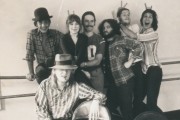 Even if the name Ralph Steadman isn’t familiar to you, you have doubtlessly seen his instantly recognizable work before, even if it was only on a bottle of one of Flying Dog Brewery’s beers, which Steadman designs. His grotesque caricatures that seem to be equal parts maniacal and insane have been at the forefront of counter-culture art for decades.
Even if the name Ralph Steadman isn’t familiar to you, you have doubtlessly seen his instantly recognizable work before, even if it was only on a bottle of one of Flying Dog Brewery’s beers, which Steadman designs. His grotesque caricatures that seem to be equal parts maniacal and insane have been at the forefront of counter-culture art for decades.
While Steadman is best known for his illustrations of Gonzo journalist Hunter S. Thompson‘s work (particularly the illustrations for Fear and Loathing in Las Vegas), he has been a working artist, illustrator, and cartoonist for fifty years. In the documentary For No Good Reason, Johnny Depp, a longtime fan of Steadman’s work, travels to Steadman’s home to speak to him about his artwork and his rich life story.
One of the great joys of the documentary is watching Steadman create several paintings. The most incredible thing about many of them is that Steadman begins with a few streaks of paint without knowing what it is that he will paint. As he explains, his goal is to “make something as unexpected to me as it is to everyone else.” When he works like this, it’s like a person trapped in a maze trying to find the way out. What Steadman sees in these blotches is what inspires him to create art and gives his objects their unique shapes that remain recognizable. As he puts it, “The essence of my work is to distort, yet maintain the likeness”
My main concern with this movie was the participation of Johnny Depp. While Depp’s starring role in the film adaptation of Fear and Loathing in Las Vegas has been many people’s introduction to the work of Thompson and Steadman, because Depp has equally billing on the poster I went into the film thinking he would take away from the focus on Steadman. This is not the case at all because the documentary focuses entirely on Steadman and Depp really serves as the “audience” that gets Steadman to speak about his work. In fact, it’s apparent that Depp is using his fame to bring even more attention to Steadman’s work, which is admirable.
Naturally, the most interesting parts of the documentary are Steadman’s collaborations with Thompson, but the documentary leaves a few unanswered questions about their relationship (it suggests that the pair had a falling out shortly before Thompson’s death, but doesn’t go into specifics). This doesn’t mean that the other parts of the documentary aren’t interesting even if they are a bit slower. I did not know much about Steadman’s Leonardo da Vinci project, nor was I aware of how deeply passionate he is about human rights. It’s also fun to see some of Steadman’s artwork animated to demonstrate how his creations would interact in the real world. Still, I would’ve liked to have seen the documentary go a bit more under the surface of Steadman’s work and impact since in its 80 minutes it really just summarizes his career history.
It’s important to note that despite the fact that Terry Gilliam and Richard E. Grant‘s names appear on the poster, combined they might only have about four minutes of screentime talking about their admiration and collaborations with Steadman. These minutes add to the film, but producers might as well have put Bill Murray‘s name on the poster too since he shows up for a minute in archival footage.
Director Charlie Paul is a newcomer to filmmaking, and I imagine it would be hard for him to top For No Good Reason without having another subject as interesting as Steadman. If you’re a fan of Steadman’s art — or even just interested in seeing a great artist at work — you’ll definitely enjoy For No Good Reason.
RATING: A look at one of the most popular counter-culture artists that sometimes doesn’t get deep enough into what inspires him (7/10).















Recent Comments